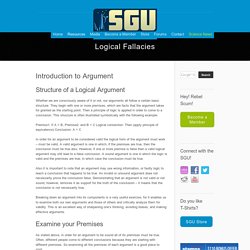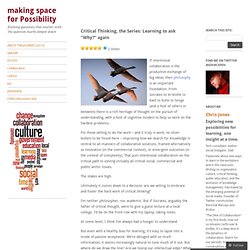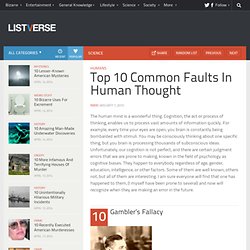

A List Of Fallacious Arguments. Attacking the person instead of attacking his argument.

For example, "Von Daniken's books about ancient astronauts are worthless because he is a convicted forger and embezzler. " (Which is true, but that's not why they're worthless.) Another example is this syllogism, which alludes to Alan Turing's homosexuality: Turing thinks machines think. Turing lies with men. Top 20 Logical Fallacies - The Skeptics' Guide to the Universe. Introduction to Argument Structure of a Logical Argument Whether we are consciously aware of it or not, our arguments all follow a certain basic structure.

They begin with one or more premises, which are facts that the argument takes for granted as the starting point. Then a principle of logic is applied in order to come to a conclusion. This structure is often illustrated symbolically with the following example: Premise1: If A = B, Premise2: and B = C Logical connection: Then (apply principle of equivalence) Conclusion: A = C. Top 20 Logical Fallacies - The Skeptics' Guide to the Universe. Strategies for critical thinking in learning, Part I. Thinking and recall series Strategies for critical thinking in learning and project management Critical thinking studies a topic or problem with open-mindedness.This exercise outlines the first stage of applying a critical thinking approach to developing and understanding a topic. You will: Develop a statement of the topic List what you understand, what you've been told and what opinions you hold about it Identify resources available for research Define timelines and due datesand how they affect the development of your study Print the list as your reference Here is more on the first stage: Define your destination, what you want to learnClarify or verify with your teacher or an "expert" on your subject Topics can be simple phrases:"The role of gender in video game playing" "Causes of the war before 1939""Mahogany trees in Central America""Plumbing regulations in the suburbs" "Regions of the human brain"
Exploratree - Exploratree by FutureLab. Critical Thinking, the Series: Learning to ask “Why?” again. If intentional collaboration is the productive exchange of big ideas, then philosophy is an important foundation.

From Socrates to Aristotle to Kant to Kuhn to Senge (and a host of others in between) there is a rich heritage of thought on the pursuit of understanding, with a host of cognitive models to help us work on the hardest problems. For those willing to do the work – and it truly is work, no silver bullets to be found here – improving how we search for knowledge is central to all manners of collaborative solutions, framed alternatively as innovation (in the commercial context), or emergent outcomes (in the context of complexity). That puts intentional collaboration on the critical path to solving virtually all critical social, commercial and public sector issues. The stakes are high. Ultimately it comes down to a decision: are we willing to embrace and foster the hard work of critical thinking? I’m neither philosopher, nor academic. Let me offer a working definition: Like this: Critical Thinking On The Web.
Top Ten Argument Mapping Tutorials.

Six online tutorials in argument mapping, a core requirement for advanced critical thinking.The Skeptic's Dictionary - over 400 definitions and essays. The Fallacy Files by Gary Curtis. Best website on fallacies. Butterflies and Wheels. Two excellent examples of close-reading « Prizing the Postcolonial Weblog. What is close reading? - a tutorial and guidance notes « Mantex. Mantex > Tutorials > 19C Literature > What is close reading?

– guidance notes a brief guide to advanced reading skills Close reading – explained 1. Close reading is the most important skill you need for any form of literary studies. 2. 3. 4. Linguistic You pay especially close attention to the surface linguistic elements of the text – that is, to aspects of vocabulary, grammar, and syntax. 5. Studying Fiction is an introduction to the basic concepts and the language you will need for studying prose fiction. Buy the book at Amazon UK Buy the book at Amazon US 6. Linguistic reading is largely descriptive. Top 10 Common Faults In Human Thought.
Humans The human mind is a wonderful thing.

Cognition, the act or process of thinking, enables us to process vast amounts of information quickly. For example, every time your eyes are open, you brain is constantly being bombarded with stimuli. You may be consciously thinking about one specific thing, but you brain is processing thousands of subconscious ideas. Unfortunately, our cognition is not perfect, and there are certain judgment errors that we are prone to making, known in the field of psychology as cognitive biases. The Gambler’s fallacy is the tendency to think that future probabilities are altered by past events, when in reality, they are not. Reactivity is the tendency of people to act or appear differently when they know that they are being observed. Pareidolia is when random images or sounds are perceived as significant. Interesting Fact: the Rorschach Inkblot test was developed to use pareidolia to tap into people’s mental states.
Self-fulfilling Prophecy. 15 Styles of Distorted Thinking.
Www.fas.harvard.edu/~wricntr/documents/CloseReading.html. Critical Thinking Home Page.